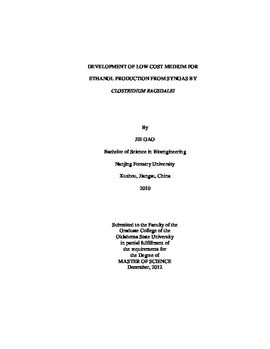| dc.contributor.advisor | Atiyeh, Hasan | |
| dc.contributor.author | Gao, Jie | |
| dc.date.accessioned | 2014-04-17T20:12:38Z | |
| dc.date.available | 2014-04-17T20:12:38Z | |
| dc.date.issued | 2012-12-01 | |
| dc.identifier.uri | https://hdl.handle.net/11244/10315 | |
| dc.description.abstract | Gasification-syngas fermentation is a hybrid conversion technology on the verge of commercialization. Lignocellulosic biomass is gasified to synthesis gas, or syngas (CO, H2 and CO2) that is converted using biocatalysts such as Clostridium ragsdalei to alcohols and organic acids. A viable commercial syngas fermentation process only utilizes necessary medium components for cell growth and fermentation of syngas to products at a low cost and high productivity. The overall objective of the present study is to reduce, eliminate or replace expensive nutrients with inexpensive nutrient supplements, thus developing a low cost and completely defined medium for ethanol production through syngas fermentation by C. ragsdalei. This includes cost analysis and examination of the effects of various medium components on growth and product profiles. Elimination and reduction in concentrations of expensive nutrients such as morpholinoethane sulfonic acid (MES) buffer, yeast extract (YE) and minerals from the medium were examined. The feasibility of developing a completely defined medium was also investigated. Fermentations were conducted in 250 mL bottles with 100 mL medium. Syngas (20% CO, 15% CO2, 5% H2 and 60% N2 by volume) was fed to C. ragsdalei every 24 h. The results showed that MES buffer could be removed from the medium and pH could be maintained at desired values using sodium bicarbonate. YE was necessary for C. ragsdalei growth; however, lower YE concentration (0.5 g/L) in medium EJ3 preferentially generated 62% more ethanol compared to standard YE (1.0 g/L) medium EJ1. Furthermore, based on cells’ elemental composition, concentrations of several media components were reformulated with reduced mineral concentrations. The cost and ethanol yield of medium EJ14 with 0.5 g/L YE and revised mineral solution III were 97% lower and 22% higher, respectively, than in medium EJ1, offering significant cost benefits for potential industrial ethanol production. In addition, although slower growth was noticed with C. ragsdalei in the completely defined medium EJ16 without YE, there were insignificant differences in ethanol production in either medium EJ16 or medium EJ14. | |
| dc.format | application/pdf | |
| dc.language | en_US | |
| dc.publisher | Oklahoma State University | |
| dc.rights | Copyright is held by the author who has granted the Oklahoma State University Library the non-exclusive right to share this material in its institutional repository. Contact Digital Library Services at lib-dls@okstate.edu or 405-744-9161 for the permission policy on the use, reproduction or distribution of this material. | |
| dc.title | Development of Low Cost Medium for Ethanol Production from Syngas by Clostridium Ragsdalei | |
| dc.type | text | |
| dc.contributor.committeeMember | Wilkins, Mark R. | |
| dc.contributor.committeeMember | Bellmer, Danielle D. | |
| osu.filename | Gao_okstate_0664M_12517.pdf | |
| osu.college | Engineering, Architecture, and Technology | |
| osu.accesstype | Open Access | |
| dc.description.department | School of Materials Science & Engineering | |
| dc.type.genre | Thesis | |
| dc.subject.keywords | bioengineering | |
| dc.subject.keywords | biofuel | |
| dc.subject.keywords | clostridium ragsdalei | |
| dc.subject.keywords | ethanol | |
| dc.subject.keywords | medium development | |
| dc.subject.keywords | syngas fermentation | |
